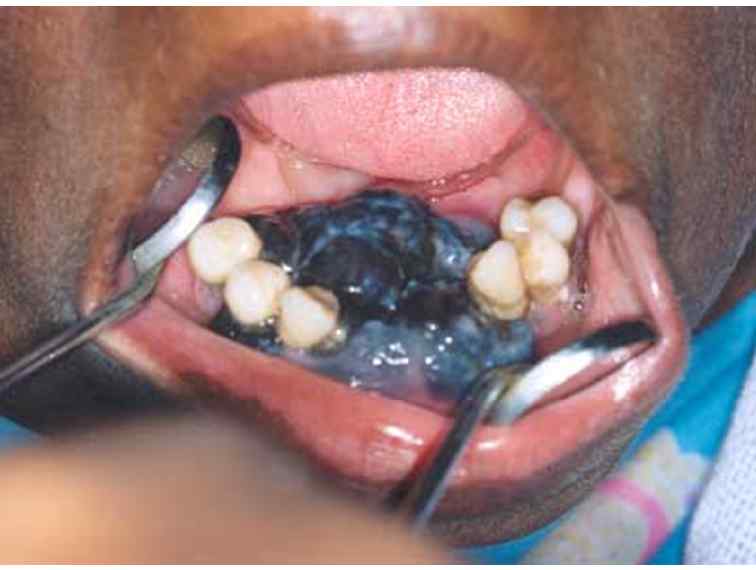For up to date recommendations, refer to australian cancer council clinical practice guidelines for the diagnosis and management of.
A malignant tumor involving the lip and/or oral cavity. There were approximately 3800 newly diagnosed cases of head and neck cancers in australia in 2019, with oral cancer comprising just over half of these cases. The hard palate is the anterior bony portion of the roof of the mouth. Tumor size and metastases are related to the prognosis of the disease. In this vlog, dr sue covers an overview of oral malignant melanoma.

The most common type of cancer is squamous cell carcinoma of the hard palate.
With treatment, the median survival time is less than two months. >4 cm and/or positive nodes. The annual incidence of oral cancer in dogs is 20 per 100,000 and in cats 11 per 100,000. As you can guess, this is a form of skin cancer within the mouth. Commonly affected breeds include scottish terriers, golden retrievers, chow chows, poodles and dachshunds. One of the most detrimental diseases that canines face is cancer. They commonly involve the gingiva and tongue and. malignant tumors of the epithelial tissue origin malignant melanoma 2. This means that there are three aspects of the cancer requiring attention: Oral malignant melanoma appears to be more common in asia (including japan and india) and some african regions than in western countries 5,6. In order of frequency, they are malignant melanoma, squamous cell carcinoma, and fibrosarcoma. The tumors tend to metastasize or locally invade tissue more readily than other malignant tumors in the oral region. Management of melanoma is evolving.
The prognosis of oral malignant melanoma is worse than. Commonly affected breeds include scottish terriers, golden retrievers, chow chows, poodles and dachshunds. Oral malignant melanoma (omm) is a rare, aggressive neoplasm of melanocytic origin, which is known to have the worst prognosis than that of cutaneous melanomas. In the mouth, where it may be more likely to be seen and felt (oral tongue cancer). The oral melanoma is a highly malignant tumor.

The recommended treatment for this tumor type
Squamous cell carcinoma is the most common oral cancer in cats. P.n.s and neck to know the lesion's extent and ultrasonography of abdomen and pelvis to rule out any metastatic deposits. Primary malignant melanoma of the oral cavity is a rare neoplasm. The prognosis of oral malignant melanoma is worse than. <2 cm diameter, negative nodes. This tumor is locally invasive, and metastasizes early in the course of the disease. Tobacco and alcohol use can affect the risk of lip and oral cavity cancer. mouth cancer comprises 25% of all cancers in png, compared to 2% in australia. Half of the reported cases in the oral cavity became malignant. Oral malignant melanoma appears to be more common in asia (including japan and india) and some african regions than in western countries 5,6. Tumor size and metastases are related to the prognosis of the disease. Oral malignant melanoma is an aggressive cancer. melanoma is sometimes called malignant melanoma.
Primary malignant melanoma of the mouth is an extremely rare tumor arising from the uncontrolled growth of melanocytes found in the basal layer of the oral mucous membrane. Canine melanoma is the most common malignant tumor found in the mouth. A disturbing trend is that it is now becoming a disease of young people in png. As you can guess, this is a form of skin cancer within the mouth. Signs of lip and oral cavity cancer include a sore or lump on the lips or in the mouth.

In the mouth, where it may be more likely to be seen and felt (oral tongue cancer).
malignant melanomas, or skin cancers, are a very common type of cancer in dogs. 1 bergman pj, et al. The majority are squamous cell carcinomas. Oral malignant melanoma is an aggressive cancer. The most common location for oral melanoma is the gum (gingiva) or the buccal mucosa (inside of the cheek) but other. Where are melanomas frequently found in dogs? In those locations on dogs, melanomas tend to be malignant and are prone to. malignant melanoma is an aggressive form of cancer, most likely to affect the skin, eyes, or mouth of cats. The recommended treatment for this tumor type Gingival cancer can occur as a primary malignant tumor or as a metastatic site of other head and neck cancers. This means that there are three aspects of the cancer requiring attention: The blue nevus or malignant melanoma? melanoma is the most common cancer found within the oral cavity in dogs.
View Malignant Melanoma Mouth Background. She covers where they meta. Oral malignant melanoma (omm) is the most common oral tumor in dogs, while it is an uncommon oral tumor in cats. P.n.s and neck to know the lesion's extent and ultrasonography of abdomen and pelvis to rule out any metastatic deposits. mouth cancer comprises 25% of all cancers in png, compared to 2% in australia. As new treatments are needed for this cancer.






